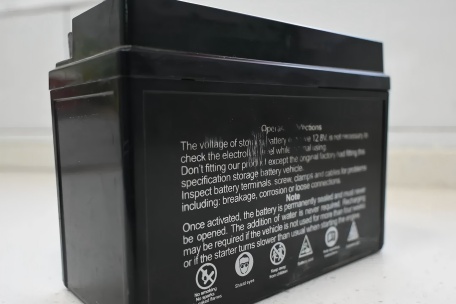Motorcycle Battery Care Tips: How to Charge and Extend Its Life

Today, we’re sharing some practical motorcycle battery tips. It might sound a little long-winded, but stick with it—you could avoid unnecessary problems and even make your battery last years longer.
1. What a Motorcycle Battery Does
A motorcycle battery—often called simply a “battery”—comes in two main types:
- Flooded (wet) lead-acid — the traditional type with liquid electrolyte.
- Sealed Lead-Acid (VRLA) — maintenance-free designs such as AGM (Absorbent Glass Mat) or gel batteries.
Some bikes also use lithium iron phosphate (LiFePO₄) batteries.
The battery acts as an auxiliary power source for your bike’s electrical system. Its main jobs are storing power and regulating voltage.
- When you first turn the key, the battery becomes the main power source.
- Once the engine is running, the alternator and regulator-rectifier take over to power the bike and recharge the battery.
If you use your battery properly and maintain it well, a factory-installed battery can often last 2 to 5 years—sometimes longer in ideal conditions.
2. Battery Maintenance Tips
“Maintenance-free” means you don’t need to add distilled water—it does not mean you can ignore the battery entirely.
Here’s how to get the best life out of your battery:
- Keep all connections secure
- Ensure proper charging
- Avoid overloading the electrical system
Modern bikes often have lots of electronic accessories. Poorly installed or high-power add-ons can exceed the alternator’s available output and drain the battery while riding. If you must install them, understand you may need to replace the battery sooner.
Most importantly, avoid leaving the battery in a low-charge state. For AGM lead-acid, an open-circuit voltage (bike off, rested for several hours) below about 12.5 volts means it’s time to recharge—waiting too long risks sulfation, which permanently reduces capacity.
3. How to Properly Charge a Motorcycle Battery
Some riders say charging is simple: clip the charger to the battery and plug it in. But that’s only part of the process.
The safest way to charge your battery:
- Turn off the motorcycle
- Disconnect the negative terminal first, then the positive terminal
- Remove the battery from the bike
- Place it in a dry, cool, ventilated area, away from flames and children
- Use a charger designed for your battery’s chemistry and with the correct power rating
- Keep the battery upright (flooded types must stay vertical; VRLA can be placed in various positions but never upside-down)
- If you see bulging, excessive heat, or a strong odor, stop immediately—these are signs of overcharging or internal failure and can be dangerous
For most riders today, a microprocessor-controlled smart charger is the best choice.
- Lead-acid: Use a multi-stage charger (bulk / absorption / float) matched to the battery type.
- LiFePO₄: Use a charger with a dedicated lithium mode or one recommended by the manufacturer; avoid long-term trickle charging.
4. How to Tell If Your Battery Is Running Low
Look for these signs:
- Horn sounds weak
- Headlights are dim
- Engine cranks slowly
If this happens, recharge the battery soon following the safe steps above.
Also check your bike’s charging system. Here’s a professional approach:
- With the engine off and the bike rested for several hours, a healthy AGM battery should read about 12.8–13.0 volts.
- With the engine at 3,000–4,000 rpm, voltage at the battery terminals should hold between about 13.0 and 14.5 volts.
- If it’s much lower or higher, inspect the stator and regulator-rectifier for issues.
Don’t forget to check your taillight. On some bikes, the brake light stays on because the brake switch doesn’t return fully. This creates a constant drain that can flatten the battery. A quick adjustment can fix it and extend battery life.
5. Special Notes for LiFePO₄ Batteries
- Resting full-charge voltage is usually around 13.2–13.4 volts.
- Most motorcycles can charge them fine, but keep voltage under about 14.4–14.6 volts.
- Avoid charging below 32°F (0°C) unless the battery’s BMS supports low-temperature charging.
Pro Tip: A healthy battery not only helps your bike start reliably but can also improve fuel efficiency and protect your electrical system.

